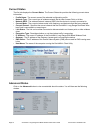
Page 17
None
If your network does not use any type of security select the None radio button and then click on the OK
button.
Advanced
The third tab displayed is the Advanced tab. Here you can configure details about an Access Point or Ad
Hoc network configuration. Each advanced setting field is described below.
• Power Save Mode - Allows you to minimize power utilized by the SonicWALL Long Range Dual Band
Wireless Card.
Warning: Setting Power Save Mode to enabled (Normal or Maximum) may cause the user to experi-
ence an extended connection delay of up to one minute.
• Network Type - Allows you to configure the SonicWALL Long Range Dual Band Wireless Card as
either an Ad hoc or Access Point type network.
• 802.11b Preamble - Allows setting the preamble support to match up with the specified wireless net-
work.
• Transmit Power Level - Allows you to modify the power output of the radio.
Warning: Setting this to any other value except for 100% will decrease range of your SonicWALL Long
Range Dual Band Wireless Card.
• Wireless Mode Setting - The wireless mode settings allow you to specify which wireless frequency
and data rate the wireless network is operating at. If all selections are chosen, the SonicWALL Long
Range Dual Band Wireless Card will automatically search all frequencies an data rates for wireless
networks that match up to the profile settings.
Note: The Turbo G and 5Ghz 108 Mbps modes should be chosen only if the client is associated to a
SonicPoint.
• Wireless Mode when starting Ad Hoc setting - The “Wireless Mode When Starting Ad Hoc Setting”
allows you to determine the type of ad hoc network to be started.
Note: This setting will only take effect if there are no other ad hoc networks with the same SSID cur-
rently operating within range. If existing ad hoc networks with the same SSID are currently operating,
then the SonicWALL Long Range Dual Band Wireless Card will connect using the frequency and data
rate provided by the exiting ad hoc network.


















